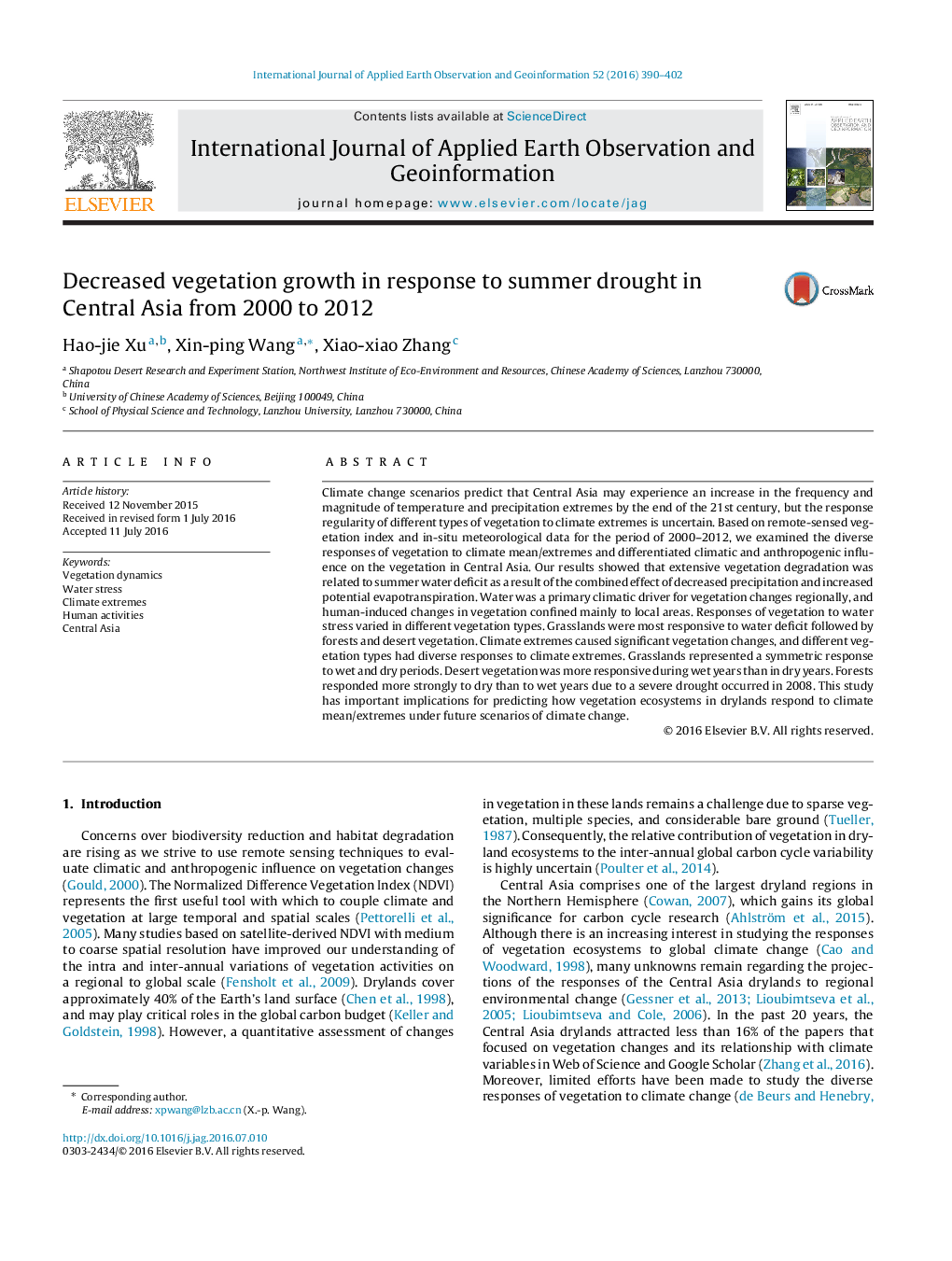| کد مقاله | کد نشریه | سال انتشار | مقاله انگلیسی | نسخه تمام متن |
|---|---|---|---|---|
| 6348499 | 1621805 | 2016 | 13 صفحه PDF | دانلود رایگان |
عنوان انگلیسی مقاله ISI
Decreased vegetation growth in response to summer drought in Central Asia from 2000 to 2012
ترجمه فارسی عنوان
کاهش رشد گیاه در پاسخ به خشکی تابستان در آسیای میانه از سال 2000 تا 2012
دانلود مقاله + سفارش ترجمه
دانلود مقاله ISI انگلیسی
رایگان برای ایرانیان
کلمات کلیدی
پویش گیاهی، تنش آبی، شدیدات آب و هوا، فعالیت های انسانی، آسیای مرکزی،
ترجمه چکیده
سناریوهای تغییر آب و هوا پیش بینی می کنند که تا پایان قرن بیست و یکم، افزایش آسیب های آسیای میانه و افزایش شدت بارش و شدت بارندگی، اما منظم بودن پاسخ گیاهان مختلف به شرایط آب و هوایی غیرممکن است. بر اساس شاخص های پوشش داده شده از راه دور و داده های هواشناسی در سالهای 2000 تا 2012، پاسخ های گوناگون پوشش گیاهی به شرایط متوسط / شدت آب و هوا و تأثیرات مختلف اقلیمی و تاثیر آن بر گیاهان در آسیای میانه مورد بررسی قرار گرفت. نتایج ما نشان داد که تخریب پوشش گیاهی گسترده به دلیل کمبود بارش در فصل تابستان مربوط به کاهش بارش و افزایش تبخیر تعرق بالقوه است. آب ریشه ای اقلیمی اساسی برای تغییرات پوشش گیاهی در منطقه بود و تغییرات ناشی از انسان در پوشش گیاهی عمدتا به مناطق محلی محدود می شد. پاسخ گیاه به تنش آب در انواع گیاهان مختلف متفاوت است. گندم بیشتر به کمبود آب پاسخ داده شد و پس از آن جنگل ها و گیاهان بیابانی مورد استفاده قرار گرفت. شدت شرایط آب و هوایی موجب تغییرات قابل توجهی در پوشش گیاهی شد و انواع مختلف پوشش گیاهی پاسخ های متنوعی به شدت آب و هوایی داشتند. چمنزارها پاسخ متقارن به دوره خیس و خشک را نشان دادند. گیاه کویر در طول سال های مرطوب پاسخگو تر از سال های خشک بود. جنگل ها به دلیل خشکی شدید در سال 2008 به شدت به خشکی نسبت به سال های مرطوب پاسخ دادند. این مطالعه پیامدهای مهمی برای پیش بینی اینکه چگونه اکوسیستم های پوشش گیاهی در خشکی به شرایط متوسط / شدت آب و هوایی در آینده در شرایط تغییر آب و هوا پاسخ می دهد.
موضوعات مرتبط
مهندسی و علوم پایه
علوم زمین و سیارات
کامپیوتر در علوم زمین
چکیده انگلیسی
Climate change scenarios predict that Central Asia may experience an increase in the frequency and magnitude of temperature and precipitation extremes by the end of the 21st century, but the response regularity of different types of vegetation to climate extremes is uncertain. Based on remote-sensed vegetation index and in-situ meteorological data for the period of 2000-2012, we examined the diverse responses of vegetation to climate mean/extremes and differentiated climatic and anthropogenic influence on the vegetation in Central Asia. Our results showed that extensive vegetation degradation was related to summer water deficit as a result of the combined effect of decreased precipitation and increased potential evapotranspiration. Water was a primary climatic driver for vegetation changes regionally, and human-induced changes in vegetation confined mainly to local areas. Responses of vegetation to water stress varied in different vegetation types. Grasslands were most responsive to water deficit followed by forests and desert vegetation. Climate extremes caused significant vegetation changes, and different vegetation types had diverse responses to climate extremes. Grasslands represented a symmetric response to wet and dry periods. Desert vegetation was more responsive during wet years than in dry years. Forests responded more strongly to dry than to wet years due to a severe drought occurred in 2008. This study has important implications for predicting how vegetation ecosystems in drylands respond to climate mean/extremes under future scenarios of climate change.
ناشر
Database: Elsevier - ScienceDirect (ساینس دایرکت)
Journal: International Journal of Applied Earth Observation and Geoinformation - Volume 52, October 2016, Pages 390-402
Journal: International Journal of Applied Earth Observation and Geoinformation - Volume 52, October 2016, Pages 390-402
نویسندگان
Hao-jie Xu, Xin-ping Wang, Xiao-xiao Zhang,
